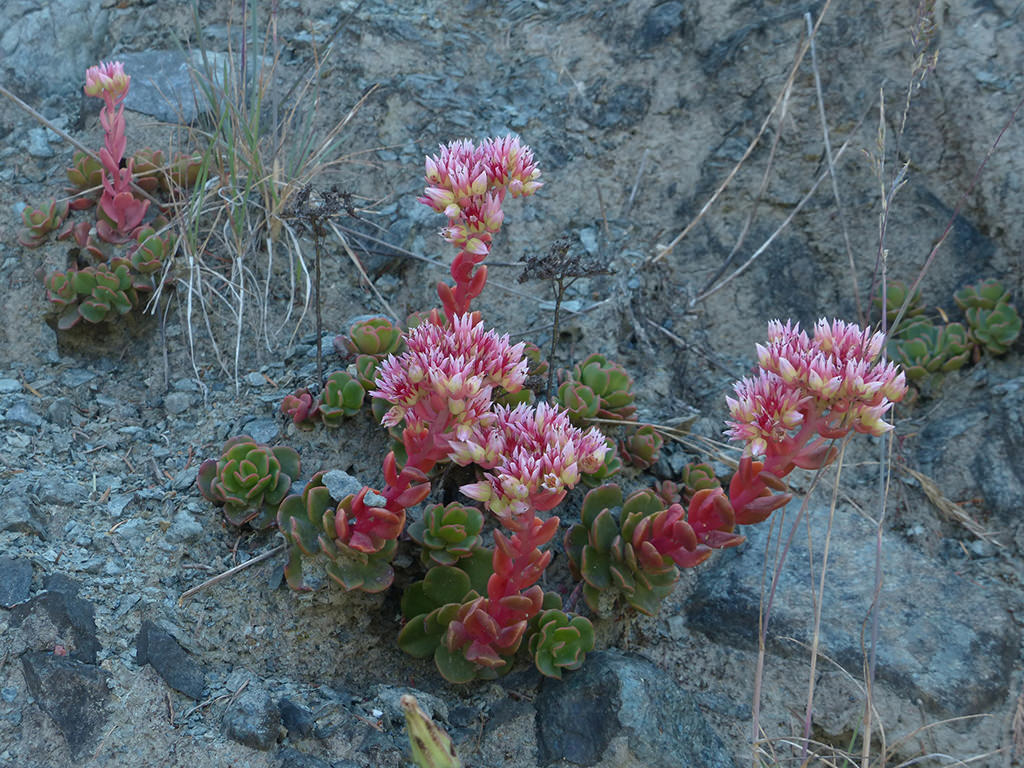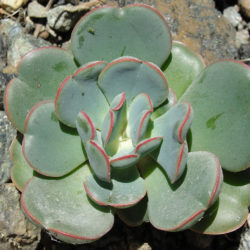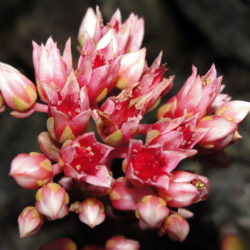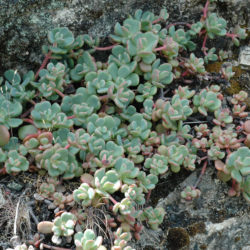Scientific Name
Sedum laxum (Britton) Berger
Common Name(s)
Rose-flowered Stonecrop, Roseflower Stonecrop
Synonym(s)
Cotyledon brittoniana, Echeveria gormanii, Gormania laxa, Sedum laxum subsp. latifolium, Sedum laxum subsp. laxum, Sedum laxum subsp. perplexum, Sedum laxum var. latifolium
Scientific Classification
Family: Crassulaceae
Subfamily: Sempervivoideae
Tribe: Sedeae
Genus: Sedum
Origin
This species is native to the United States (southwestern Oregon and northwestern California). It occurs mainly on serpentine soils at elevations below 4000 feet (1220 m).
Description
Sedum laxum is a succulent plant with stout branched rootstocks forming terminal rosettes of thick, fleshy, green, usually glaucous leaves. It branches readily and spreads as a sprawling ground cover. Leaves are oblanceolate, spatulate, or obovate, up to 2 inches (5 cm) long and up to 7 inches (1.8 cm) wide. Flowers appear on erect or decumbent, simple or branched, up to 16 inches (40 cm) long stalks in summer. They are pink, pinkish-white, or white to yellowish-white and have red, reddish-purple, red-brown, or yellow anthers.
Etymology
The specific epithet "laxum (LAX-um)" is the neuter form of the Latin adjective "laxus," meaning "loose, slack, free," and refers to the growth habit of this species.

How to Grow and Care for Sedum laxum
Light: This succulent grows best in locations where it will enjoy the full sun for at least six hours per day. It will tolerate partial shade but will not thrive in deep shade. Keep your indoor plant in a sunny window or under artificial lights.
Soil: S. laxum does not like to sit in waterlogged soil, so drainage is essential to prevent root rot. Choose a well-draining soil mix.
Hardiness: This plant is tolerant of heat and freezing temperatures. S. laxum can withstand temperatures as low as -10 to 30 °F (-23.3 to -1.1 °C), USDA hardiness zones 6a to 9b.
Watering: From spring through fall, water thoroughly and wait for the soil to dry out before watering again. In winter, water your plant just enough to keep it from shriveling. Avoid wetting the leaves, stems, and flowers when watering.
Fertilizing: Feed with a balanced organic fertilizer in spring. Feeding is unnecessary as long the plant is divided annually and provided with fresh soil.
Repotting: Repot your plant when it outgrows its current pot by moving it out to a larger container to hold the plant better. Spring is the best time to repot S. laxum. Make sure the soil is dry before you begin repotting.
Propagation: Once you have one S. laxum, it is easy to make more by taking stems or leaf cuttings and dividing the plant. It is also easy to grow from seed. Take cuttings in spring when the plant is in the period of active growth. Once it has finished flowering, it is the right time for division. Spring or summer is the best time to sow the seeds.
Learn more at How to Grow and Care for Sedum.
Toxicity of Sedum laxum
S. laxum is not listed as toxic for people but can be mildly toxic to pets and children.
Links
- Back to genus Sedum
- Succupedia: Browse succulents by Scientific Name, Common Name, Genus, Family, USDA Hardiness Zone, Origin, or cacti by Genus
Photo Gallery
Click on a photo to see a larger version.


